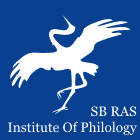 |
|
||||||||||||
|
Institute of Philology of
the Siberian Branch of Russian Academy of Sciences |
|
||||||||||||
|
|||||||||||||
| Sibirskii Filologicheskii Zhurnal (Siberian Journal of Philology) | |
|
Article
Authors: Maria V. Bobrova Institute for Linguistic Studies of the Russian Academy of Sciences, St. Petersburg, Russian Federation In the section Linguistics
Abstract: The paper investigates the principles underlying the organization of toponymic space in correlation with geographical space. The focus is on the toponymic material of the Perm region. The discussion of data sources acknowledges the limited availability of early information concerning the oikonym system in the region, emphasizing the importance of local sources, such as population and land censuses. The most informative regional settlement lists are those compiled since the 19th century, with the 1928 edition considered the most comprehensive and authoritative. The most prevalent word formation patterns in oikonyms prove to be (1) terms derived from the “Geographical terminology” vocabulary and (2) metonymic place names that correlate with the names of adjacent geographical objects. The naming of settlements is frequently tied to three fundamental geographical elements: topographical variations, forested regions, and water sources. Taiga spatial organization has three dimensions: horizontal, vertical, and the movement “vector” related to the water flows. While the detailed specification of oikonyms might suggest a naming duplication of local topography, a comparative analysis has revealed the substantial influence of a value-oriented approach on naming practices. The research demonstrated a distinct linguocultural character, confirming the universality of the organizational patterns of onymic space previously identified by V. A. Nikonov and E. L. Berezovich and emphasizing the paramount importance of the cultural-value principle in space exploration. Keywords: onomastics, oikonymy, toponymic model, principles of nominating, linguocultural aspect, Perm Krai Bibliography: Belyaeva O. P. Mestnaya leksika, svyazannaya s oboznacheniyami zemel’nykh uchastkov [Local vocabulary related to land designations]. In: Voprosy fonetiki, slovoobrazovaniya, leksiki russkogo yazyka i metodiki ego prepodavaniya [Issues of phonetics, word formation, vocabulary of the Russian language and methods of teaching it]. Perm, 1964, iss. 1, pp. 93–103. Berezovich E. L., Russkaya toponimiya v etnolingvisticheskom aspekte: Prostranstvo i chelovek [Russian toponymy in ethnolinguistic aspect: Space and human]. Moscow, Librokom, 1998, 328 p. Bogacheva M. V. Novaya epokha – novaya kul’tura? [New era is new culture, isn’t it?]. In: Slovo i tekst v kul’turnom soznanii epokhi: materialy Vseros. nauch.-prakt. konf. [Word and text in the cultural consciousness of the era: materials of All-Russ. sci.-pract. conf.]. Vologda, 2008, pp. 353–361. Karpenko Yu. A. Svoystva i istochniki mikrotoponimii [Properties and sources of microtoponymy]. In: Mikrotoponimiya [Microtoponymy]. Moscow, Nauka, 1967, pp. 15–22. Korchagin P. A., Lobanova A. S. Ocherki ranney istorii Permi Velikoy: vodno-volokovye puti [Essays on the early history of Perm the Great: waterways]. Perm University Herald. History. 2012, no. 1(18), pp. 121–134. Nikonov V. A. Vvedenie v toponimiku [Introduction to toponymy]. Moscow, LKI, 2011, 184 p. Polyakova E. N. Materialy pamyatnikov 16 – nachala 18 v. dlya toponimicheskogo slovarya Permskogo kraya [Materials of the monuments of the 16th – early 18th centuries for the toponymic dictionary of the Perm region]. M. V. Bobrova (Ed.). Perm, 2020, 168 p. Polyakova E. N., Novikov V. F. Dialektnaya leksika v Cherdynskikh i Solikamskikh pamyatnikakh 17 veka [Dialect vocabulary in Cherdyn and Solikamsk monuments of the 17th century]. In: Zhivoe slovo v russkoy rechi Prikam’ya [A living word in the Russian speech of the Kama region]. Perm, 1972, iss. 3, pp. 155–168. Polyakova E. N. Pamyat’ yazyka: Rasskazy o leksike permskikh pamyatnikov pis’mennosti i govorov [Memory of language: Stories about the vocabulary of Perm monuments of writing and dialects]. Perm, Perm. kn. izd., 1991, 206 p. Superanskaya A. V. Chto takoe toponimika? Iz istorii geograficheskikh nazvaniy [What is toponymy? From the history of geographical names]. Moscow, Librokom, 2021, 178 p. Superanskaya A. V. Obshchaya teoriya imeni sobstvennogo [General theory of proper names]. Moscow, Librokom, 2012, 366 p. Vostrikov O. V. Finno-ugorskiy substrat v russkom yazyke [Finno-Ugric substratum in Russian]. Sverdlovsk, 1990, 95 p. Zhitnikov V. F. Drevnerusskaya leksika podsechno-ognevogo zemledeliya v toponimike Arkhangel’skoy i Vologodskoy oblastey [Old Russian vocabulary of slash-and-burn agriculture in the toponymy of the Arkhangelsk and Vologda regions]. Voprosy toponomastiki. 1965, iss. 2, pp. 19–22. |
 |
Institute of Philology Nikolaeva st., 8, Novosibirsk, 630090, Russian Federation +7-383-330-15-18, ifl@philology.nsc.ru |
© Institute of Philology |


